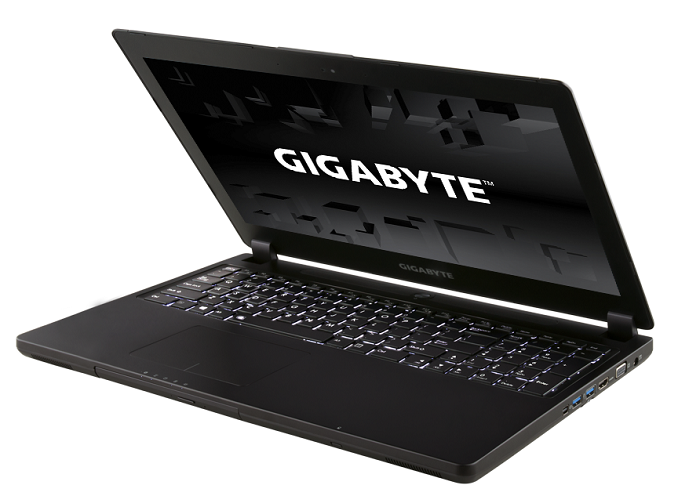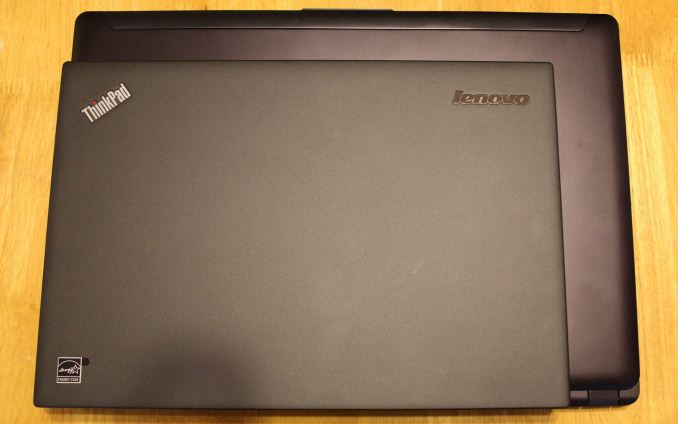The Gigabyte P35X v3 Review: Slim GTX980M Gaming Laptop
by Brett Howse on April 23, 2015 8:00 AM EST
Gigabyte has refreshed its P35 series to include the latest NVIDIA GPUs, and the P35X is the top model in their 15.6 inch lineup. Gigabyte has the lightest GTX980M gaming laptop available, with the P35X v3 coming in at just 2.3 kg (5.07 lbs) thanks to the all-aluminum chassis. At just 20.9 mm (0.82”) thick, it is a fairly portable laptop considering the components inside.
Buyers should not be short on computing power. The P35X comes equipped with the Intel Core i7-4710HQ processor, which has a TDP of 47 watts for the four cores to play in. The base frequency is 2.5 GHz with a turbo of 3.5 GHz. Optionally, you can opt for the i7-4720HQ, which is 100 MHz more of both base and turbo frequency, or Gigabyte is even offering the i7-4860HQ which is 2.4-3.6 GHz and comes with the Iris Pro 5200 GPU. The GTX980M is top tier as well, with 8 GB of GDDR5 memory available. System memory is a solid 16 GB, which is plenty for any gaming scenario and also a good amount for doing things like virtual machines or the like. Storage is likely not going to be a problem either, with the P35X coming standard with two 128 GB SSDs in RAID0 as the system drives, and an additional 1 TB 7200 rpm hard disk for extra storage. The P35X even has an optical drive as an option, but the optical drive can be removed to save weight, or an additional storage drive can be used instead, meaning the P35X has room for four drives!
 Gigabyte P35X v3 compared to 14" ThinkPad
Gigabyte P35X v3 compared to 14" ThinkPad
A lot of that comes down to the large body of a 15.6 inch laptop. Although a 14 inch and 15.6 inch laptop sound like they are pretty close in size, in reality a 15.6 inch device is significantly larger in every dimension. This opens up a lot of space for things like extra cooling, additional storage, more ports, and much more space for the keyboard of course, so the P35X features a number pad on the right side.
Below is a table of the specifications of the P35X for reference.
| Gigabyte P35X v3 Specifications | |||||
| Processor | Intel Core i7-4710HQ Quad-core + HT 2.5 - 3.5 GHz, 6MB Cache, 47W (As tested) Intel Core i7-4720HQ Quad-core Eight-Thread 2.6 - 3.6 GHz, 6MB Cache, 47W Intel Core i7-4860HQ Quad-core Eight-Thread 2.4 - 3.6 GHz, 6MB Cahce, 47W |
||||
| Memory | 8 - 16 GB DDR3L-1600 dual-channel (16 GB tested) | ||||
| Graphics | Integrated GPU Intel HD 4600 (20 EUs, 400-1200 MHz) Intel Iris Pro 5200 (i7-4860HQ model) (40 EU GT3e, 200-1200MHz) Discrete GPU NVIDIA GTX980M GM204 1536 CUDA Cores, 1038 MHz + Boost, 8 GB GDDR5 |
||||
| Display | 15.6" 1920x1080 IPS LCD 15.6" 2880x1620 IPS LCD (Panasonic) (As tested) |
||||
| Storage | 128/256/512GB mSATA SSD 128/256/512GB mSATA SSD + 500/750GB/1TB/2TB 2.5" HDD 5400rpm/7200rpm 128/256/512GB mSATA SSD + 128/256/512GB mSATA SSD + 500/750GB/1TB/2TB Optional Fourth Drive Tray if DVD is removed |
||||
| Optical Drive | Blu-Ray RW Drive DVD RW Drive |
||||
| Networking | Intel Dual Band Wireless-AC 7260 2x2:2 802.11ac 866 Mbps plus Bluetooth Realtek Gigabit Ethernet |
||||
| Audio | 2 x 1.5 watt speakers plus Woofer Dolby Digital Plus Home Theater |
||||
| Battery/Power | Li-Polymer 75.81 Wh 180W Max AC Adapter |
||||
| Left Side | Lock Slot Ethernet 2x USB 2.0 Headset jack with SPDIF Microphone jack SD Card Reader |
||||
| Right Side | DC Input VGA Connection HDMI Port 2 x USB 3.0 Mini DisplayPort |
||||
| Back Side | Exhaust Vents | ||||
| Operating System | Windows 8.1 | ||||
| Dimensions | 15.16" x 10.63" x 0.82" (WxDxH) 385 mm x 270 mm x 20.9 mm |
||||
| Weight | 5.07 lbs / 2.3 kg | ||||
| Extras | 720p HD Webcam Backlit keyboard |
||||
| Pricing | $1999.00 and up | ||||
As you can see, the P35X is a well configured device, with 802.11ac wireless, a large battery, and plenty of ports. This laptop has almost every port that has ever been available on a laptop, with Gigabit Ethernet, two USB 3.0 ports, two USB 2.0 ports, mini DisplayPort, HDMI, VGA, a SPDIF headphone jack, and a SD card reader. The word kitchen sink comes to mind, but there is plenty of real estate to add the ports, so it is hard to complain about them being there.
Gigabyte has made a great choice with the display as well. The 15.6 inch diagonal display has a 1920x1080 as the base model, or optionally you can go with the 2880x1620 version like the review sample that Gigabyte has sent. The resolution is not unique to this device, but it works very well for a gaming laptop. The resolution is not so high that you need to use really high scaling on the desktop, nor is it so high that the GTX980M will struggle excessively at this resolution when gaming. You may have to turn the resolution down a notch or two for some of the newest games, but as we will see in the GPU performance section, many games are very playable at the native resolution of the panel.
There is quite a bit of competition in this space, but if you are looking for a powerful and portable gaming system, the P35X has a lot to offer. On paper, it should be able to trade blows with any other 15.6 inch system, so let’s dig into the aspects of the laptop and see how it holds up under closer inspection.










55 Comments
View All Comments
xilience - Thursday, April 23, 2015 - link
Any thoughts for why there is such a large difference in FPS in GRID:Autosport versus the Clevo?SpaceRanger - Thursday, April 23, 2015 - link
From the looks of it.. The Clevo is sporting a true 4790k(84w), while the Gigabyte's using a 4710HQ(47w) CPU. Apples and Oranges comparison in my eyes.nerd1 - Thursday, April 23, 2015 - link
It's as slow as razer blade with 970M - which means the whole system throttles a lot under pressure, even compared to razer blade (which is not well known for great cooling)Brett Howse - Thursday, April 23, 2015 - link
That's not what it means at all. It means that GRID Autosport is more CPU bound. The Clevo with the desktop CPU is way ahead. Razer has a faster CPU and slower GPU, but it's still behind.xKrNMBoYx - Friday, April 24, 2015 - link
Okay so some of the benchmarks include the MSI GT72 Dominator Pro with basically the same CPU and GPU. Yet all those benchmarks show the P35X beating the GT72 even though they are similar. So if a thin P35X can beat a more roomy GT72 with better cooling how is the P35X suffering from throttling issues?The next thing to come to mind logically would be the comparison of the CPUs as the Clevo is using a full 4790K that can run all cores on 4GHz and then the 4720HQ (Razerblade) which is better than the 4710HQ (P34X). Every benchmark here shows the 980M in the P35X beating the 970M by at least ~10FPS and you look at one benchmark where the difference is less than 10FPS and say they perform the same?
Frumious1 - Friday, April 24, 2015 - link
Different drivers would be the reason. GT72 was tested when GTX 980M was practically brand new. NVIDIA had several driver updates that provided substantial increases to performance since last October/November. Too bad AnandTech can't go back and retest some of their previous laptops and update performance with the latest drivers.xKrNMBoYx - Monday, April 27, 2015 - link
You're right. I was hoping/expecting they did those tests over again. The lastest driver update did boost the desktop Maxwell GPU performances. Seeing that I do have a GT72 Pro with a 980M I should be able to try running a few of these game benchmarks to see if I get similar numbers.nerd1 - Thursday, April 23, 2015 - link
This review looks extremely shallow - it almost skipped over its main concern (thermal). A single 3D game for thermal testing? Seriously? Since when Anandtech review became like this?hfm - Thursday, April 23, 2015 - link
At least the system cooling solution noise was mentioned, which sounds like a deal-breaker in my eyes.nerd1 - Thursday, April 23, 2015 - link
Games rarely utilize CPU at all, and many games do not push GPU either. Most other hardware sites uses synthetic tests designed to really push the hardware, and then tests a number of demanding games too.And face it, you cannot cram x80M GPU and quadcore CPU inside 20mm thin body and expect it to run cool and silent. Even 17 inch gaming rigs sometimes throttle.